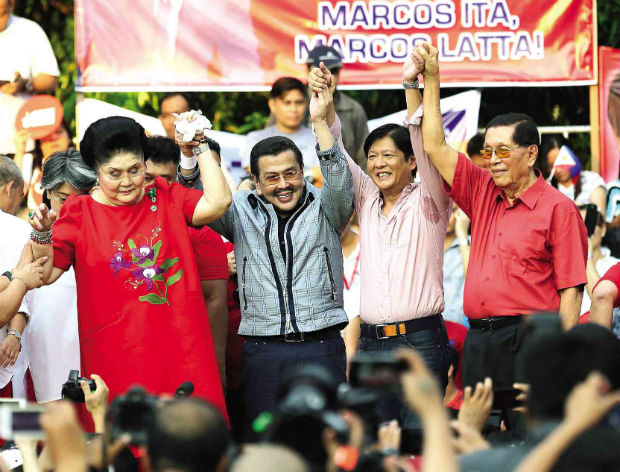The return of the Marcos nightmare

VP HOPEFUL Controversial politicians (from left), former first lady and now Ilocos Norte Rep. Imelda Marcos, Manila Mayor Joseph Estrada and Sen. Juan Ponce Enrile (right), raise the hands of Sen. Ferdinand “Bongbong” Marcos. Bongbong declared his vice presidential bid during a proclamation rally in Intramuros, Manila, on Saturday. RAFFY LERMA/INQUIRER
ON SEPT. 23, the 43rd anniversary of the declaration of martial law in the Philippines by President Ferdinand Marcos, Filipinos were stunned to read on the front page of their newspapers, flaunting the picture of the leading functionaries of the martial law regime assembled on a stage, that Sen. Bongbong Marcos, the dictator’s son, was running for the vice presidency in the 2016 elections.
The picture showed former first lady Imelda Marcos and former Defense Secretary Juan Ponce Enrile, the martial law administrator, gloating and unrepentant for their roles in that darkest hour of Philippine democracy.
It was a wrong time for the Marcos heirs to reappear in the spotlight, and for Bongbong Marcos to proclaim his vice presidential bid. Their return to the front page was a cynical display of their attempt to revise the history of martial law, rehabilitate their image and blot the stigma of martial rule on the Marcos regime.
To most Filipinos who suffered the rigors of the dictatorship for 14 years, the imposition of martial law was a day of infamy, not an event to remember with triumphalist commemoration by the Marcos family and their cohorts.
Insensitivity
Outside of that stage, memories of the victims of atrocities and abuses of the military-backed regime flooded the press, speaking of the realities under martial law.
Nothing could match the contempt and insensitivity of the Marcos heirs to the democratic tradition than their own commemoration of the event in which they announced they were back on the center stage of Philippine politics, returning from disgrace and exile in Hawaii after they had been driven out by the Edsa People Power Revolution of 1986, with impunity and without being punished for the colossal corruption and pillage of the nation’s wealth and for the deaths of and atrocities committed against thousands of regime opponents, both from the left and the center.
In the presentation of Bongbong’s aspirations for no less than the second-highest office in the land, the Marcos family swept under the carpet all the sordid records of human rights abuses and violations and judicial investigations into the looting and “crony capitalism” of the martial law regime.
History falsified
The first fraud foisted by Marcos on the Filipino people when he imposed martial law to launch his New Society, against the background of military marches, was that he falsified history. He signed Proclamation No. 1081 on Sept. 21, l972, placing the Philippines under martial law. The proclamation was announced on national television on Sept. 23. By that time, troops had raided and shut down Congress and newspaper offices and arrested 200 targets, mostly opposition leaders and critical journalists.
Throughout the martial law period, Marcos perpetuated the myth that Sept. 21 was the date of the foundation of his New Society. The propaganda effort succeeded in deluding the Filipino people that martial law was proclaimed on Sept. 21, 1972. It was not.
In reality, a week before the actual declaration, a number of people, including journalists, had received information that Marcos had already drawn up a plan to completely take over the government and gain absolute power.
In fact, Sen. Benigno Aquino Jr., in a privilege speech on Sept. 13, exposed what he called Oplan Sagittarius. He disclosed that he had received a top secret plan by Marcos to place Metro Manila and outlying areas under control of the Philippine Constabulary as a prelude to martial law.
Marcos was going to use a series of bombings in Metro Manila, including the 1971 Plaza Miranda bombing, as justification for his takeover and subsequent authoritarian rule. In his diaries, Marcos wrote on Sept. 14, 1972, that he informed the military that he would proceed with the proclamation of martial law. The US Embassy knew as early as Sept. 17 about Marcos’ plans.
Martial law study
In his memoir, then Justice Secretary Juan Ponce Enrile recalled that on a late afternoon in December 1969, Marcos instructed him to study the presidential powers as Commander in Chief under the 1935 Constitution. Marcos made the instruction as he “foresaw” the “escalation of violence and disorder in the country.” He ordered that the “study must be done discreetly and confidentiality.”
At about the same time, Marcos also instructed Executive Secretary Alejandro Melchor and Brig. Gen. Jose Almonte to study how martial law was implemented in different parts of the world. Marcos wanted to know the consequences of declaring martial law. The result of their study stated that “while martial law may accelerate development, in the end, the Philippines would become a political archipelago, with debilitating, factionalized politics.”
Almonte recalled that the findings led to the conclusion that “the nation would be destroyed because, apart from the divisiveness it would cause, martial law would offer Marcos absolute power, which would corrupt absolutely.”
By the end of January 1970, Enrile, with the help of Efren Plana and Minerva Gonzaga Reyes, submitted the only copy of the confidential report on the legal aspects and extent of martial law to Marcos. A week later, Marcos summoned Enrile and instructed him to prepare the documents for the implementation of martial law.
On May 8, 1972, Marcos wrote that he had instructed the military to update its plans, including the list of personalities to be arrested, and had met with Enrile to finalize the paperwork.
On Aug. 1, 1972, Marcos met with a few of his most trusted military commanders to discuss tentative dates for the declaration of martial law—to fall within the next two months. The dates they considered either ended in 7 or were divisible by 7, which Marcos considered his lucky number.















